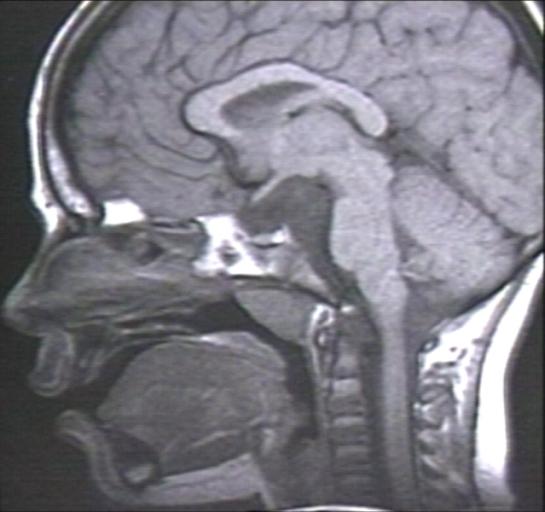Arachnoid cyst
| Arachnoid cyst | ||
 | ||
|---|---|---|
| Suprasellar Arachnoid Cyst; Extension into posterior fossa and displacing the pons (T1 - MRI) Image courtesy of Professor Peter Anderson DVM PhD and published with permission © PEIR, University of Alabama at Birmingham, Department of Pathology | ||
| ICD-10 | Q04.6 | |
| ICD-9 | 348.0 | |
| OMIM | 207790 | |
| DiseasesDB | 33219 | |
| MeSH | D016080 | |
|
Arachnoid cyst Microchapters |
|
Diagnosis |
|---|
|
Treatment |
|
Case Studies |
|
Arachnoid cyst On the Web |
|
American Roentgen Ray Society Images of Arachnoid cyst |
Editor-In-Chief: C. Michael Gibson, M.S., M.D. [1]
Prognosis
Untreated, arachnoid cysts may cause permanent severe neurological damage due to the progressive expansion of the cyst(s) or hemorrhage (bleeding).[1] With treatment most individuals with arachnoid cysts do well with the double edge sword of developing surgical arachnoiditis which can cause its own specific problems and can lead to "popping" another cyst.
More specific prognoses are listed below:
- Patients with arachnoid cysts of the left temporal fossa who experienced impaired preoperative cognition had postoperative improvement.[2]
- Surgery can resolve psychiatric manifestations in selected cases.[3]
Epidemiology
Arachnoid cysts are seen in 4% of the population.[4] Only 20% of these have symptoms, usually from secondary hydrocephalus.[4]
A study that looked at 2,536 healthy young males found a prevalence of 1.7% (95% CI 1.2 to 2.3%). Only a small percentage of the detected abnormalities require urgent medical attention.[5]
See also
- Acoustic Neuroma
- Arachnoiditis
- Brain Tumors, General
- Dandy-Walker Syndrome
- Empty Sella Syndrome
- Epidermoids
- Midline Caves of the Brain
- Porencephaly
- Syringomyelia
- Bobble-Head Doll Syndrome
- Hyperprolactinemia
- Panhypopituitarism
- Arnold-Chiari Malformation
Patient Information
What are Arachnoid Cysts?
Arachnoid cysts are cerebrospinal fluid-filled sacs that are located between the brain or spinal cord and the arachnoid membrane, one of the three membranes that cover the brain and spinal cord. Primary arachnoid cysts are present at birth and are the result of developmental abnormalities in the brain and spinal cord that arise during the early weeks of gestation. Secondary arachnoid cysts are not as common as primary cysts and develop as a result of head injury, meningitis, or tumors, or as a complication of brain surgery. The majority of arachnoid cysts form outside the temporal lobe of the brain in an area of the skull known as the middle crania fossa. Arachnoid cysts involving the spinal cord are rarer. The location and size of the cyst determine the symptoms and when those symptoms begin. Most individuals with arachnoid cysts develop symptoms before the age of 20, and especially during the first year of life, but some people with arachnoid cysts never have symptoms. Males are four times more likely to have arachnoid cysts than females.
Typical symptoms of an arachnoid cyst around the brain include headache, nausea and vomiting, seizures, hearing and visual disturbances, vertigo, and difficulties with balance and walking. Arachnoid cysts around the spinal cord compress the spinal cord or nerve roots and cause symptoms such as progressive back and leg pain and tingling or numbness in the legs or arms. Diagnosis usually involves a brain scan using diffusion-weighted MRI (magnetic resonance imaging) which helps distinguish fluid-filled arachnoid cysts from other types of cysts.
Is there any treatment?
There has been active debate about how to treat arachnoid cysts. The need for treatment depends mostly upon the location and size of the cyst. If the cyst is small, not disturbing surrounding tissue, and not causing symptoms, some doctors will refrain from treatment. In the past, doctors placed shunts in the cyst to drain its fluid. Now with microneurosurgical techniques and endoscopic tools that allow for minimally invasive surgery, more doctors are opting to surgically remove the membranes of the cyst or open the cyst so its fluid can drain into the cerebrospinal fluid and be absorbed.
What is the prognosis?
Untreated, arachnoid cysts may cause permanent severe neurological damage when progressive expansion of the cyst(s) or hemorrhage injures the brain or spinal cord. Symptoms usually resolve or improve with treatment.
What research is being done?
The National Institute of Neurological Disorders and Stroke (NINDS) conducts research related to brain abnormalities and disorders of the nervous system such as arachnoid cysts in laboratories at the National Institutes of Health (NIH), and supports additional research through grants to major medical institutions across the country. Much of this research focuses on finding better ways to prevent, treat, and ultimately cure neurological disorders such as arachnoid cysts.
References
- ↑
- ↑ Wester K, Hugdahl K. "Arachnoid cysts of the left temporal fossa: impaired preoperative cognition and postoperative improvement." J Neurol Neurosurg Psychiatry 1995 Sep;59(3):293-8. (PMID 7673959)
- ↑ Kohn R, Lilly RB, Sokol MS, Malloy PF. "Psychiatric presentations of intracranial cysts", J Neuropsychiatry Clin Neurosci 1989; 1:60-66. (PMID 2577719)
- ↑ 4.0 4.1 Flaherty AW. The Massachusetts General Hospital Handbook of Neurology 2000 Jan 1;105. (ISBN 0-683-30576-X)
- ↑ Weber F, Knopf H. "Incidental findings in magnetic resonance imaging of the brains of healthy young men", J Neurol Sci. 2006 Jan 15;240(1-2):81-4. Epub 2005 Oct 26. (PMID 16256141)
External Links
Patient support sites: